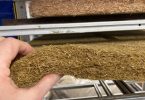This thesis describes the procedure for obtaining an insulation value for straw bales for construction. A modified hotplate was placed between two bales and temperature readings were taken at various locations in and on either side of the straw bales, this is referred to as a “modified guarded hot plate procedure”. An R-Value of 52 (H-FT^2-F/BTU-Bale) was determined for wheat bales. Rice straw bales have a similar insulating value. This R-value was used to demonstrate the energy requirements of a residential building constructed with straw bales.
The use of this value has wide-ranging implications on energy use for buildings. In order to compare straw bale insulation to more traditional insulation materials the Arizona home energy rating program, CalRes, was used. An average residential building energy usage decrease of 12.4% per year was determined by using straw bales. Straw is an anisentropic material. Insulating values of bales varies with position. Heat flow against the grains has a higher insulating value (R=3.15/inch) than heat flowing with the grains (R=2.38/inch). Moisture content and bale density also effect insulating values.
Author: McCabe, Joseph






